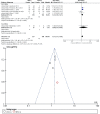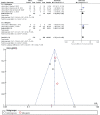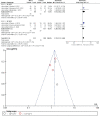Mesenchymal stem cells transplantation for perianal fistulas: a systematic review and meta-analysis of clinical trials
- PMID: 37101285
- PMCID: PMC10134595
- DOI: 10.1186/s13287-023-03331-6
Mesenchymal stem cells transplantation for perianal fistulas: a systematic review and meta-analysis of clinical trials
Erratum in
-
Correction: Mesenchymal stem cells transplantation for perianal fistulas: a systematic review and meta-analysis of clinical trials.Stem Cell Res Ther. 2024 Feb 16;15(1):45. doi: 10.1186/s13287-024-03664-w. Stem Cell Res Ther. 2024. PMID: 38365762 Free PMC article. No abstract available.
Abstract
Background: Perianal fistulas, characterised as granulomatous inflammation of fistulas around the anal canal, are associated with significant morbidity resulting in a negative impact on quality of life and a tremendous burden to the healthcare system. Treatment of anal fistulas usually consists of anal surgery; however, results of closure rates are not satisfactory especially with complex perianal fistulas, after which many patients may suffer from anal incontinence. Recently, the administration of mesenchymal stem cells (MSCs) has shown promising efficacy. Herein, we aim to explore whether MSCs are effective for complex perianal fistulas and if they have either short-term, medium-term, long-term or over-long-term efficacy. Additionally, we want to elucidate whether factors such as drug dosage, MSC source, cell type, and disease aetiology influence treatment efficacy. We searched four online databases and analysed data based on information within the clinical trials registry. The outcomes of eligible trials were analysed with Review Manager 5.4.1. Relative risk and related 95% confidence interval were calculated to compare the effect between the MSCs and control groups. In addition, the Cochrane risk of bias tool was applied to evaluate the bias risk of eligible studies. Meta-analyses showed that therapy with MSCs was superior to conventional treatment for complex perianal fistulas in short-, long- and over-long-term follow-up phases. However, there was no statistical difference in treatment efficacy in the medium term between the two methods. Subgroup meta-analyses showed factors including cell type, cell source and cell dosage were superior compared to the control, but there was no significant difference between different experimental groups of those factors. Besides, local MSCs therapy has shown more promising results for fistulas as a result of Crohn's Disease (CD). Although we tend to maintain that MSCs therapy is effective for cryptoglandular fistulas equally, more studies are needed to confirm this conclusion in the future.
Short conclusion: MSCs Transplantation could be a new therapeutic method for complex perianal fistulas of both cryptoglandular and CD origin showing high efficacy in the short-term to over-long-term phases, as well as high efficacy in sustained healing. The difference in cell types, cell sources and cell dosages did not influence MSCs' efficacy.
Keywords: Clinical trials; Efficacy and safety; Healing rate; Mesenchymal stem cells transplantation; Perianal fistulas; Randomised controlled trial; Systematic review and meta-analysis.
© 2023. The Author(s).
Conflict of interest statement
The company—Life Spring AKY Pharmaceuticals—just provided researching funds and did not provide any other service or product to the study. HY Jiang is the staff of this company. The authors declare that they have no competing interests.
Figures











Comment in
-
Comments on: "Mesenchymal stem cells transplantation for perianal fistulas: a systematic review and meta-analysis of clinical trials".Stem Cell Res Ther. 2023 Dec 18;14(1):375. doi: 10.1186/s13287-023-03607-x. Stem Cell Res Ther. 2023. PMID: 38110978 Free PMC article.
References
-
- Kotze PG, et al. Modern management of perianal fistulas in Crohn's disease: future directions. Gut. 2018;67(6):1181–1194. - PubMed
-
- Zanotti C, et al. An assessment of the incidence of fistula-in-ano in four countries of the European Union. Int J Colorectal Dis. 2007;22(12):1459–1462. - PubMed
-
- Lawrence LS, et al. Granulomas in diagnostic biopsies associated with high risk of Crohn's complications-but may be preventable. Inflamm Bowel Dis. 2022;28(4):523–530. - PubMed
-
- Sainio P. Fistula-in-ano in a defined population. Incidence and epidemiological aspects. Ann Chir Gynaecol. 1984;73(4):219–24. - PubMed
Publication types
MeSH terms
LinkOut - more resources
Full Text Sources
Medical

